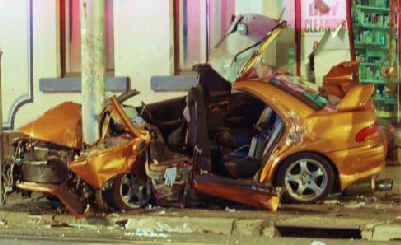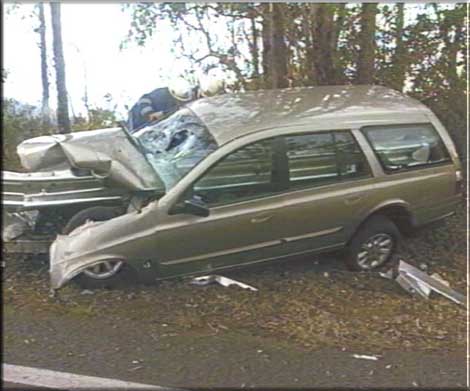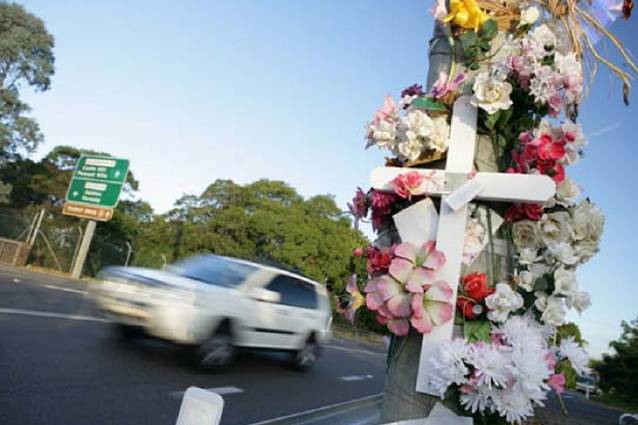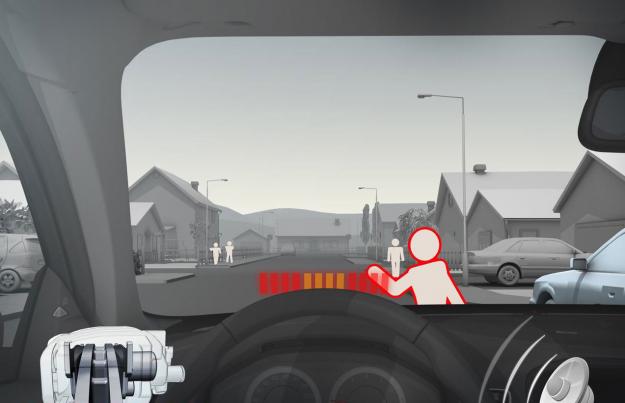Chapter 19: CRASH SAFETY
DRIVING DANGERS
Driving a motor vehicle is a simple task, we do it everyday.
But it is also the most dangerous thing you’ll ever do.
When we put the keys in the ignition we take command of a weapon far deadlier than any gun. We are in control of 1.5 tonnes of steel, glass and rubber capable of traveling at speeds of up to 65 metres per second. Because we drive so often and nothing bad happens, we easily become complacent to the dangers.
Over the past 10 years approximately 17,000 Australians have been killed and a further 1.5 million Australians involved in road crashes. That’s a lot of unnecessary death and injury.
Each year in Queensland there is an estimated 30,000 car crashes, that injure 15,000 and kill approximately 300.
If you drive a car you are an accident waiting to happen.
If you are a young driver, be aware that one third of all those killed; injured and involved in road crashes are 17-25 years old. Road trauma is a leading cause of death amongst young Australians
It is every parent’s greatest fear that their son or daughter will be killed as a driver or passenger in a motor vehicle crash. Unfortunately statistics demonstrate this tragic waste of life occurs all too often.
If you drive a company car be aware that the Federal Office of Road Safety and the National Safety Council recognize that road crashes are the most common cause of work related deaths, injuries and absence from work in Australia. On average a company vehicle will have a crash once every five years with the average total cost to the company being $18,500.
The cost of crashes to the community are far higher; each life lost costs an estimated $800,000.
Yes speed, alcohol and fatigue are killers stalking us on the road, but so to is over-confidence, inexperience, peer pressure, a lack of concentration, a need to show off and our foolish believe that it won’t happen to us.
Accidents happen to all road users. No one is exempt.
Those that take more risks have more accidents.
So what makes a good driver?
Having a licence, being a racing driver, having a safe car, being able to drive faster than everyone else in heavy traffic or wet weather, out performing or maneuvering other drivers, the fact that you haven’t had an accident yet?
What makes you think you’re not an accident waiting to happen.
Being a good driver is about understanding the attitude and behavior of others, about knowing your own limitations and the limitations of your vehicle, about managing the risks we take, about understanding road rules and why not all drivers follow them, about making our vehicle safe and being ready for the unexpected. Safe Drive Training can show you how.
We urge you to invest in your life by becoming the best driver you can be.
A drivers licence has not taught you everything you need to know and years of driving experience are not always the best teacher.
Under the current licencing system driver performance is rated on simple control skills performed under ideal conditions. A licence is gained far too easily and unfortunately their is no requirement to continually update our driving skills and awareness.
Safe Drive Training is committed to improving the driver education and safety of all road users. Our team of instructors work with industry, the media, road safety researchers and the community to improve the safety of all road users.
Whether your a novice just starting to drive, a parent carrying the most precious cargo of all, the driver of a company car or an enthusiast looking for a safe place to find your limits, Safe Drive Training has a specific driver education and training program for you. After all Safe Drivers are Life Savers.
Unfortunately for those most at risk there is nothing we can tell you, no video you can see, no car control skills that you can learn that will highlight the hidden dangers of driving; like having a car crash. What a terrible way to learn a lesson.
We all make mistakes, no one is a perfect driver. But sometimes these mistakes have fatal consequences and sometimes we can become involved in other peoples mistakes.
Our attitude and what motivates us as a driver is the key to managing the risks we take when driving.
For example speed and what motivates drivers to speed is an area that can increase the risk of having a crash.
- Trying to drive at 25 kph faster than the surrounding traffic increases your risk of a crash by 10 times. One day another driver will misjudge the speed and distance of your approach and leave you with no where to go.
- Those doing the dance of death at high speed through a roundabout late at night will have fun until the night they misjudge clip a kerb and meet a power pole face to face.
- The driver and passengers seeing how fast their car can go may wish they were at home when the under inflated tyre explodes and says sorry make your own arrangements from here.
- The driver speeding down a side street to get ahead in traffic may blame the child they run over for riding their bike in what was normally a quiet suburban street. But we know who is really to blame.
- A speeding driver at night may get a kangaroo as a bonnet emblem because their stopping distance exceeded the range of their headlights.
Its all about what motivates us to drive like we do.
Driving to survive is about driving like everyone is out to get you, because if you don’t they will get you. Let other drivers have there accidents somewhere else.
But always be prepared for the unexpected.
Safe Drive Training asks you to re-evaluate your driving and the risks you unknowingly take every single day. Driving is a simple task, driving safely is the hard part.
The following figures from the ETSC PIN Annual Report 2009 and also from the International Road Traffic and Accidents Database [IRTAD].
Numbers shown to the left of various country names indicate the relative positions of the ‘mainstream' road safety countries. Figures to the right-hand side of country names show Road Deaths per Million Population
---
Marshall Islands . . . 17 [4]
--
San Marino . . . . . . . 32 [4]
---
Malta . . . . . . . . . . . 37 * [1]
01
Sweden . . . . . . . . . 43
02
UK . . . . . . . . . . . . .44 *
03
The Netherlands . . 46
04
Switzerland . . . . . . .47
---
Singapore . . . . . . . .48 [4]
05
Iceland . . . . . . . . . .49 [2]
06
Japan . . . . . . . . . . .52 [2]
07
Norway . . . . . . . . . .54
08
Germany . . . . . . . . .54 *
09
Israel . . . . . . . . . . . .57
10
Ireland . . . . . . . . . . .63
11
Finland . . . . . . . . . . 65 *
---
St. Vincent & Gren. . 66 [4]
12
Spain . . . . . . . . . . . .68 *
13
France . . . . . . . . . . .69
14
Australia . . . . . . . . . 69
---
FYR Macedonia . . . . 69 [4]
---
Fiji . . . . . . . . . . . . . .70 [4]
---
Tonga . . . . . . . . . . . .70 [4]
15
Denmark . . . . . . . . . .72 *
16
Luxembourg . . . . . . . .72
---
Kiribati . . . . . . . . . . . .74 [4]
17
Italy . . . . . . . . . . . . . 79 *
18
Austria . . . . . . . . . . . 81
19
Portugal . . . . . . . . . . 83
20
Belgium . . . . . . . . . . 86 *
---
Cuba . . . . . . . . . . . . 86 [4]
21
Canada . . . . . . . . . . 92 [3]
---
Tuvalu . . . . . . . . . . . 95 [4]
---
Uzbekistan . . . . . . . .97 [4]
22
Estonia . . . . . . . . . . 98
---
Serbia . . . . . . . . . . . 98 [4]
23
Hungary . . . . . . . . . .99
---
Nouru . . . . . . . . . . . .99 [4]
24
New Zealand . . . . . .100 [2]
25
Czech Republic . . . .104
26
Cyprus . . . . . . . . . .104
27
Slovenia . . . . . . . . .106
---
Bosnia/Herzegovina .109 [4]
---
Mauritius . . . . . . . . 111 [4]
28
Slovakia . . . . . . . . .112
---
Columbia . . . . . . . . 117 [4]
---
Ecuador . . . . . . . . . 117 [4]
---
Bahrain . . . . . . . . . .121 [4]
---
Cambodia . . . . . . . . 121 [4]
29
USA . . . . . . . . . . . .122
---
Barbados . . . . . . . . 122 [4]
---
Bangladesh . . . . . . .126 [4]
---
El Salvador . . . . . . . .126 [4]
30
Korea . . . . . . . . . . . 127 [2]
---
Panama . . . . . . . . . .127 [4]
---
Puerto Rico . . . . . . . 128 [4]
---
Samoa . . . . . . . . . . .128 [4]
---
Azerbaijan . . . . . . . . 130 [4]
---
Turkey . . . . . . . . . . . 134 [4]
---
Honduras . . . . . . . . . 135 [4]
---
Sri Lanka . . . . . . . . . 135 [4]
---
Croatia . . . . . . . . . . .136 [4]
---
Argentina . . . . . . . . . 137 [4]
---
Chile . . . . . . . . . . . . 137 [4]
---
Brunei Darussalam . . 138 [4]
31
Bulgaria . . . . . . . . . . 139
32
Latvia . . . . . . . . . . . .139
---
Albania . . . . . . . . . . .139 [4]
---
Armenia . . . . . . . . . . 139 [4]
33
Greece . . . . . . . . . . .142 *
34
Romania . . . . . . . . . .142
35
Poland . . . . . . . . . . . 143
36
Lithuania . . . . . . . . . .148
KEY:
* Provisional figures
1 Special conditions apply to Malta's low rate of deaths (according to ETSC)
2 Year 2007 data
3 Year 2006 data
4 WHO Global Status Report - June 2009 (some are estimates)NEW VEHICLE SAFETY SYSTEMS
Vehicle designers are constantly seeking improved safety systems, often though the company is seeking to exploit these systems as a marketing edge. Systems currently under development include;
- Enhanced Visual Imaging (night sensors)
- Intelligent Cruise Control (automatically brakes if closure rate is high)
- Alcohol Interlocks
- Route Guidance Systems
- Intelematics Cruise Control (GPS system monitors a cars position on road compared with the set speed limit and retards engine to limit excess speed)
- Intelligent Speed Adaptation (3 stage: Flashing light or audible warning to alert driver; Positive Throttle Pressure to make pedal harder to depress; Fuel cut-out to limit speed)
- Dual Stage Airbags
- Integral Seat and Seatbelt (sash belt located in seat back to always maintain correct angle)
- Head and Chest Side Airbags
- The Inflatable Curtain (a full length airbag covering both front and rear side windows and doors)Seatbelt AirbagKnee Bolsters (airbag that protects the legs under the dashboard)
- Active Head Restraints (head rests reduce whiplash)
- Post-crash Trauma Management Systems (car notifies a communications base of crash, crash speed and GPS location so that help can be co-ordinated immediately)
The Post-crash Trauma Management Systems are being trailed by several manufacturers in the United States. The added technology is simply a GPS navigation device, a mobile phone and a crash event recorder which monitors engine speed, vehicle speed, brake use and throttle position, plus the change of velocity in the crash, whether the airbags deployed and if seatbelts were in use.
Written by Joel Neilsen, Managing Director, Safe Drive Training)





